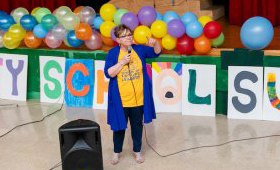New York —The Children’s Aid Society and The Finance Project today announced the release of a case study whose promising results and companion guide will enable community schools around the country to demonstrate a significant social return on investment (SROI) for this proven education reform strategy, which brings together under one roof essential academic, health, parent engagement and social services.
In the first analysis of its kind of the community schools model, The Finance Project piloted a methodology to examine the SROI of two Children’s Aid community school sites in Washington Heights, P.S. 5/Ellen Lurie Elementary School and its sister site, the Salomé Ureña de Henriquez Campus (which houses grades six to 12). The case study shows that every dollar invested in the schools over a three-year period produced a $10.30 and $14.80 return in social value respectively.
“Calculating social return on investment provides a sound and practical way to measure and communicate the value of community schools,” said Cheryl D. Hayes, president of The Finance Project and co-author of the case study and guide.
The study identifies eight primary goals for the schools—among them readiness to enter school, academic success, health and safety, and family and school engagement—and analyzes more than 40 measurable outcomes required to achieve them. While community schools serve a wide range of stakeholders, the beneficiaries of the schools’ activities are defined for the study as infants and young children, from birth to age five; students; families; and the school community.
After extensive research of third party sources, the authors assigned financial values to each benefit and gathered cost data to reflect the monetary value—in terms of improved outcomes, revenues generated and costs avoided—of the resources needed to run community schools. Next, the deadweight, or portion of the benefit that would have happened regardless, was subtracted from the total costs and benefits. Once the benefits were adjusted to reflect the value of past investments in current dollars, or net present value, the figure was divided by the investment costs and the resulting ratio serves as the SROI.
In the U.S., the concept of social return on investment was developed by venture philanthropy fund REDF (also known as The Roberts Enterprise Development Fund) in the 1990s. The approach, which is a modified cost-benefit analysis, has been used previously to evaluate investments in workforce development, prison alternatives and climate change interventions, among others.
The strong results from this case study bolster a decade of findings from independent evaluations of The Children’s Aid Society’s community schools. Previously, gains in math and reading, student and teacher attendance, and parent and caregiver involvement, as well as reports of a positive school climate, have all been shown to be higher in community schools than comparison schools. In addition, the schools’ onsite health clinics have been demonstrated to prevent costly emergency room visits and provide more timely access to mental health services than traditional schools.
A companion publication provides a comprehensive, three-step guide, complete with tools and worksheets, to help community school leaders measure and communicate the social and economic value of their schools and programs.
The community schools chosen for the case study provide services in four major areas: expanded learning opportunities (including after-school and summer programs); onsite or school-linked health and mental health services; parent education and engagement; and other family support services. These services are integrated into the school day and provided to those most in need of academic and social boosts. The Children’s Aid Society currently partners in 16 community schools in New York City.
With as many as 5,000 community schools currently operating in 44 states and the District of Columbia, serving an estimated 5.1 million students, the case study provides evidence of the effectiveness of a model that is proliferating in its third decade and gaining significant attention from lawmakers at the federal, state and local level.
A January report to the governor by the New York Education Reform Commission recommended reorganizing schools “by integrating social, health and other services through community schools to improve student performance.” Community schools run by Children’s Aid are cited in the report as a “homegrown success story” and “model of education-centered, comprehensive” programs. In New York City, the City Council speaker has endorsed the “strategic, coordinated” approach of community schools as part of a four-point strategy for the future of education here.
“It is a huge leap forward to have a standard for judging how community schools bring a solid return on investment and ensure student success,” said Richard R. Buery, Jr., president and CEO of The Children’s Aid Society. “With the release of these results and the dissemination of our guide, we hope to get one step closer to our goal of making every school a community school.”
Download the case study here.
Download the companion guide here.
About The Children’s Aid Society
The Children’s Aid Society is an independent, not-for-profit organization established to serve the children of New York City. Our mission is to help children in poverty to succeed and thrive. We do this by providing comprehensive supports to children and their families in targeted high-needs New York City neighborhoods. Founded in 1853, it is one of the nation’s largest and most innovative non-sectarian agencies, serving New York’s neediest children. Services are provided in community schools, neighborhood centers, health clinics and camps. For additional information, please call Anthony Ramos at (212) 949-4938/ (917) 204-8214, email anthonyr@childrensaidsociety.org or visit www.childrensaidsociety.org.
About The Finance Project
The Finance Project is an independent nonprofit research, training, consulting, and technical assistance firm for public- and private-sector leaders nationwide. It specializes in helping leaders plan and implement financing and sustainability strategies for initiatives that benefit children, families, and communities. Through a broad array of tools, products, and services, The Finance Project helps leaders make smart investment decisions, develop sound financing strategies, and build solid partnerships. To learn more, visit http://www.financeproject.org.



